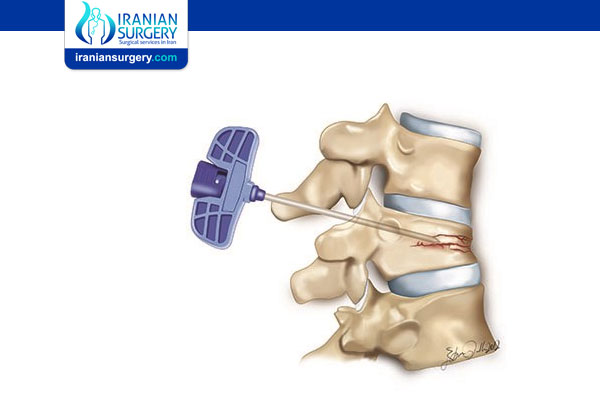Kyphoplasty/Vertebroplasty
What is a Kyphoplasty/Vertebroplasty?
Kyphoplasty/vertebroplasty are ways of treating vertebral body compression fractures, which are small breaks in the thick mass of bone that makes up the front part of your spinal column (the vertebral body). Vertebral body fractures lead to the collapse or compression of a vertebra, causing your spine to shorten and curve forward. This can result in pain and a kyphotic (hunched-over) deformity.
Thinning of bones, or osteoporosis, is the main cause of vertebral compression fractures. Pathologic fractures related to spinal tumors may also be a cause.
Before Kyphoplasty/Vertebroplasty
Who is a candidate for kyphoplasty/vertebroplasty procedures? What kinds of conditions are treated?
Kyphoplasty/vertebroplasty are generally reserved for people with painful progressive (increasing) back pain caused by osteoporotic or pathologic vertebral compression fractures. Candidates for these procedures often have a reduced ability to move and function because of the fractures.
To be a candidate for a kyphoplasty/vertebroplasty, your pain must be related to the vertebral fracture, and must not be due to other problems, such as disk herniation, arthritis, or stenosis (narrowing). Imaging tests — such as spinal x-rays, bone scans and computed tomography (CT) or magnetic resonance imaging (MRI) scans — might be ordered to confirm the presence of a vertebral fracture. If you have osteoporosis, your healthcare provider may order a dual energy x-ray absorptiometry (DXA) scan.
What type of anesthesia is used during a kyphoplasty/vertebroplasty procedure?
Kyphoplasty/vertebroplasty are considered minimally invasive procedures that are most often performed using general or local anesthesia, depending on the healthcare provider and your needs.
Is it an inpatient or outpatient procedure?
The procedure is typically performed as an outpatient procedure. You’ll be sent home the same day.
Risks / Benefits
What are the benefits of kyphoplasty/vertebroplasty?
After the bone cement is inserted into the vertebra (vertebroplasty), 75% of patients are active again. You might be symptom free and you won’t have to do physical therapy or rehabilitation.
What are the risks?
Kyphoplasty/vertebroplasty is very low-risk. There’s a slight chance you could get an infection, bleeding, increased back pain or numbness and tingling. If you have osteoporosis, there is a risk of developing additional fractures at other vertebral bodies in your spine. To avoid this risk, your healthcare provider will want to ensure that you are on medications to improve your bone quality.
Is kyphoplasty/vertebroplasty painful?
You may feel sore in the area where the trocar was inserted. However, this should resolve within a couple of days. Applying ice to the area can help relieve any soreness.
What happens before the procedure?
At an appointment before your procedure your healthcare provider may do the following:
. Perform a typical physical exam.
. Have your spine x-rayed.
. Discuss recent illnesses.
. Talk about any allergies you may have.
. Have you list the medications you’re taking.
. Order blood tests.
. Have you stop taking aspirin, nonsteroidal anti-inflammatory drugs and blood thinners.
. Have you stop eating or drinking anything for up to three hours before the procedure.
. Instruct you to not wear jewelry.
. Instruct you to wear loose, comfortable clothing.
During Kyphoplasty/Vertebroplasty
How does the procedure work?
During the kyphoplasty/vertebroplasty procedure, you’ll lie on your stomach. The healthcare provider will insert a hollow needle, called a trocar, through your skin and into the vertebra. A type of x-ray, called a fluoroscopy, is used to guide the trocar into the proper position.
Once the trocar is in place, either cement (vertebroplasty) or an inflatable balloon-like device (kyphoplasty) is inserted into the vertebra through the trocar. During a kyphoplasty, as the balloon is inflated, it opens up a space to be filled with bone cement.
After Kyphoplasty/Vertebroplasty
What happens after the procedure?
You’ll need someone to drive you home following the kyphoplasty/vertebroplasty. You can return to normal activities, but try to avoid hard effort like heavy lifting for at least six weeks.
You might feel pain relief right away, or it might take a few days. Pain caused by the procedure itself should be gone within two to three days.
Keep the bandage on for two days. Take showers instead of baths. Listen to any other instructions from your healthcare provider.
Recovery and Outlook
How effective is kyphoplasty/vertebroplasty?
Kyphoplasty/vertebroplasty usually provides pain relief and improved mobility (movement) within 48 hours of the procedure. In some cases, however, you may feel pain relief immediately.
When can I go back to work/school?
The majority of patients are satisfied with the results, with many returning to most of their usual activities they were performing before the vertebral fracture.
When to call the doctor
When should I contact my healthcare provider?
Contact your healthcare provider right away if you get an infection, have excess bleeding, feel numbness or tingling, or if the pain gets worse.
Source:
. https://my.clevelandclinic.org/health/treatments/11277-kyphoplastyvertebroplasty

